What is it about?
This study identified how characteristics of European bees can shape how well they cope with different land uses. We used data from over 250 species and 1500 sites across Europe, making it one of the most comprehensive studies of European bee diversity to date. This new research suggests that smaller bees which are active for less time during the year are particularly sensitive, but the effects varied across different land uses.
Featured Image
Why is it important?
This research highlights how the fate of Europe’s bees doesn’t just depend on their ecology, or on the land use where they live, but a combination of both. We can now take an important step towards effective conservation by trying to intervene when there’s a bad combination. For instance, the small species that specialise on particular flowers are especially sensitive to more intensive cropland. They might therefore benefit from land management that encourages more flowers – but only if the flowers are close enough to their nests, because they don’t fly very far to look for food.
Read the Original
This page is a summary of: Ecological traits affect the sensitivity of bees to land‐use pressures in
E
uropean agricultural landscapes, Journal of Applied Ecology, September 2015, Wiley,
DOI: 10.1111/1365-2664.12524.
You can read the full text:
Contributors
The following have contributed to this page










